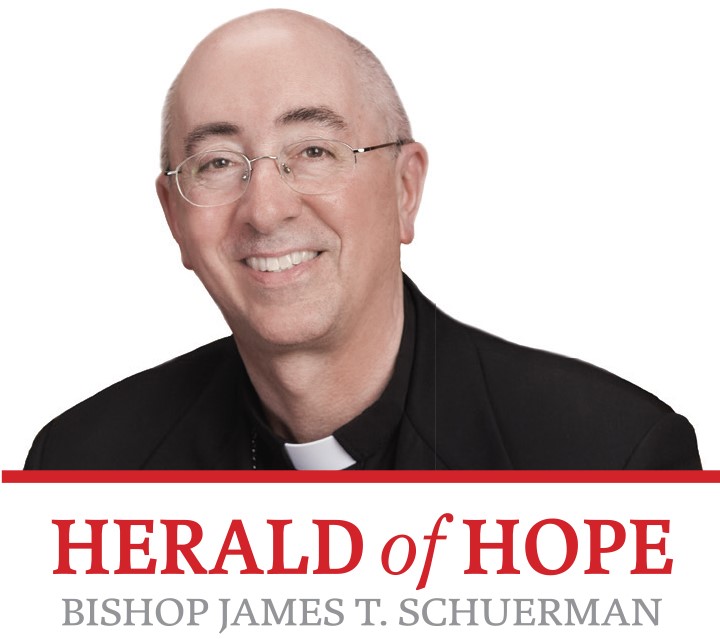Herald of Hope
Whenever I administer the Sacrament of Confirmation to young people, I tell them that the celebration of Confirmation is like another Pentecost. The form of the renewal of the baptismal promises used in the rite reflects this truth. The bishop asks the young people, “Do you believe in the Holy Spirit, the Lord, the giver of life, who today through the Sacrament of Confirmation is given to you in a special way just as he was given to the Apostles on the day of Pentecost?”
On Sunday, June 5, we will be celebrating the great solemnity of Pentecost. In the Jewish faith, the Feast of Weeks is celebrated seven weeks, or 50 days, after Passover. It is also known as Pentecost, derived from Greek and referring to the 50th day. Pentecost was originally an agricultural feast marking the end of the grain harvest, but eventually became a feast to commemorate God’s giving of the covenant to the people of Israel at Mount Sinai. In the giving of the Ten Commandments, God called Israel to be his own people. The Book of Exodus depicts the experience of the covenant at Mount Sinai in terms of a great theophany – an experience of God – with smoke, fire and thunder peals. Moses ascended the mountain amidst all these mighty signs, as described in Exodus 19.
The feast of Pentecost was a great pilgrimage festival, and devout Jews from all over the known world came to Jerusalem to worship and celebrate. The Acts of the Apostles described Jerusalem on the day of Pentecost as filled with “Parthians, Medes, Elamites, inhabitants of Mesopotamia, Judea and Cappadocia, Pontus and Asia, Phrygia, Pamphylia, Egypt and the districts of Libya near Cyrene, as well as travelers from Rome, both Jews and converts to Judaism, Cretans and Arabs.” (Acts 2:9-11)
On the day of Pentecost, the disciples were waiting and praying in a room in Jerusalem. When the Holy Spirit came upon the disciples, there was another theophany – the sound of a driving wind and tongues of fire. It was audible in the rush of wind and visible in the tongues of fire, which were signs of the presence of the invisible Holy Spirit. The disciples, filled with the Holy Spirit, went into the streets of Jerusalem, speaking in languages other than their own about the mighty acts of God, and the people of different nationalities present in Jerusalem understood them.
The Acts of the Apostles portrayed Pentecost as a renewal of God’s covenant. Once again, God called a people to be his own. In the Sinai covenant, the people, who accepted God’s invitation, were Israelites. In Acts 2:9-11, there were Jews of many nationalities, who heard the preaching of the Good News. With the Pentecost event in Jerusalem, a broader evangelization had begun, which ultimately would include Gentiles as God’s own people.
Before the coming of the Holy Spirit, the disciples were inactive and somewhat helpless. Once filled with the Spirit, they actively proclaimed the wonders of God. The ecstatic behavior of the disciples looked to the observers to be drunkenness. Dispelling this misconception, Peter stood up and delivered his first sermon (Acts 2:14-36), in which he unfolded a summary of the Gospel. Inspired by the Holy Spirit, Peter spoke about Jesus crucified and resurrected, and how his death and resurrection brought about freedom from sin and death. He called the people to repent, be baptized and receive the gift of the Holy Spirit.
Peter saw the Pentecost event as a fulfillment of the prophecy of the Prophet Joel: “I will pour out my Spirit upon all mankind. Your sons and daughters shall prophesy, your old men shall dream dreams, your young men shall see visions.” (Joel 3:1) Peter recounted the great works of Jesus, his death and resurrection, and provided Scriptural evidence that he is Lord and Messiah.
The image of the people of diverse nationalities and languages listening to and understanding the Apostles, and then coming forward to repent and be baptized, points to an essential theme of the celebration of Pentecost – that of unity in diversity. Pope Francis, in his Pentecost homily in 2020, spoke of the theme of unity in this way: “Here we come to understand what the secret of unity is, the secret of the Spirit. It is gift. For the Spirit himself is gift: he lives by giving himself and, in this way, he keeps us together, making us sharers in the same gift. It is important to believe that God is a gift, that he acts not by taking away, but by giving.”
Our understanding of the Holy Spirit as God’s self-giving love is important, because it shapes the way we live our faith. Pope Francis went on to say, “If we realize that what we are is his gift, free and unmerited, then we too will want to make our lives a gift. By loving humbly, serving freely and joyfully, we will offer to the world the true image of God. The Spirit, the living memory of the Church, reminds us that we are born from a gift and that we grow by giving: not by holding on but by giving of ourselves.”
As we celebrate Pentecost, we realize that we are not simply recalling the story of the coming of the Holy Spirit upon the Apostles. Rather, we are celebrating the ways in which the Holy Spirit is at work in our lives, transforming our hearts and unifying us as members of the Church. The Holy Spirit gives us the gifts and the blessings that we need to be self-giving instruments of God’s love and mercy in this world. We celebrate Pentecost by loving others, serving those in need and reflecting God’s image by our attitudes and actions.

